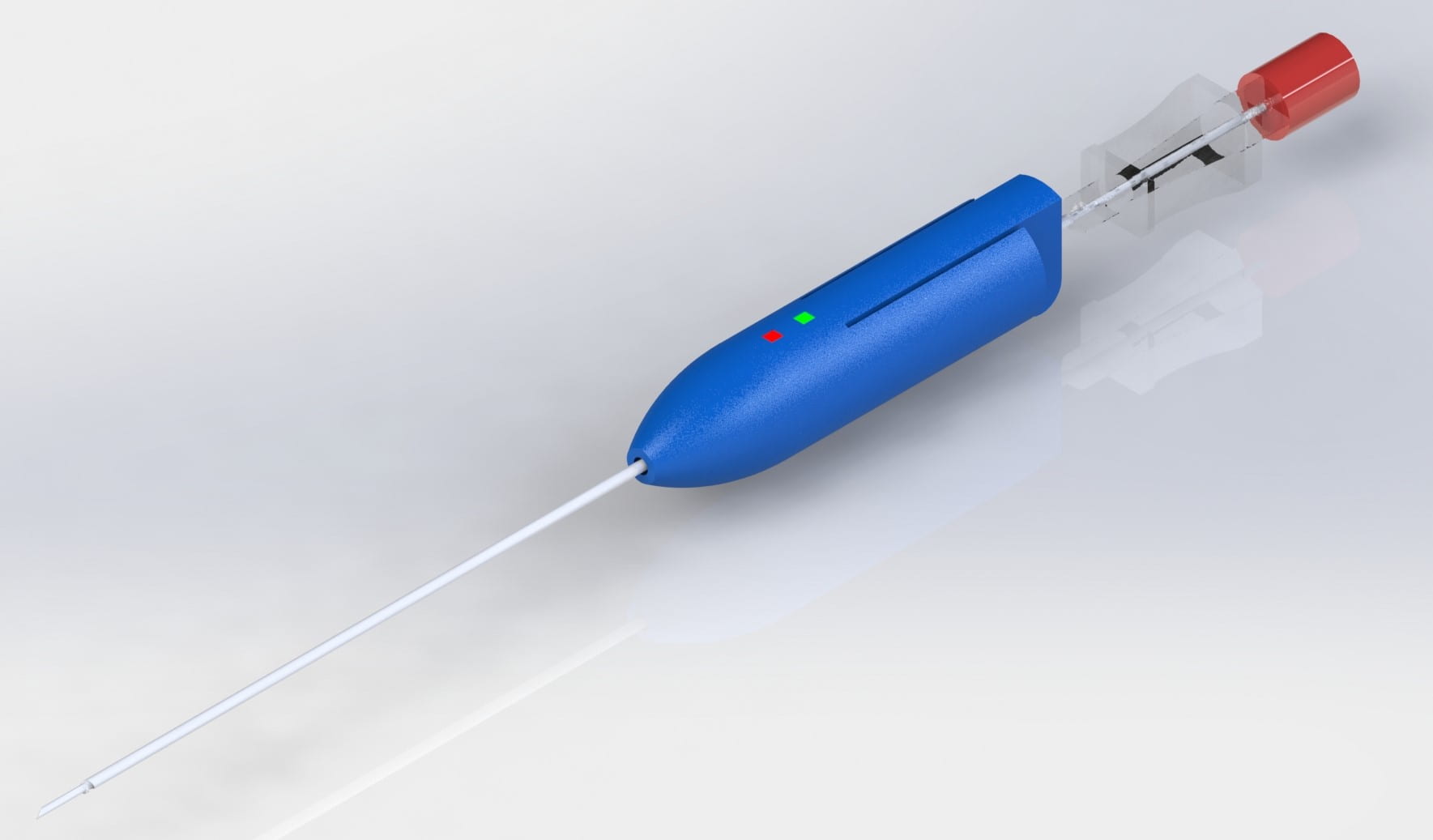Meet Georgia Tech BME Fall 2021 Capstone Team Five of Hearts
The Unmet Need
Heart disease, Viral infections, autoimmune diseases, and cancer can all cause excess fluid to fill the pericardial sac. Physicians frequently perform “pericardiocentesis” by inserting a large 18-gauge needle through the patient’s chest and into the pericardial space to drain this fluid. Unfortunately, the needle can unintentionally perforate the vascular heart in up to 50% of these procedures, and 1 in 4 people die due to this complication.
The Solution
To reduce the risk of unintentional puncture of the vascular heart during pericardiocentesis, Team Five of Hearts devised the SafeCentesis, a device with a novel, half-coiled tip for parallel entry into the pericardium intending to allow physicians to more safely access and drain the pericardial space by entering the pericardium by no more than 1cm.
 “On route to our first prototype, the top challenge was testing,” said Drew. “It is an inherently invasive procedure and device. In early stages, we needed to recreate the human anatomy with synthetic materials. But the rigidity and elasticity of silicon models could not adequately replicate the same properties as real tissue found in a human cadaver or substantially equivalent animal model.”
“On route to our first prototype, the top challenge was testing,” said Drew. “It is an inherently invasive procedure and device. In early stages, we needed to recreate the human anatomy with synthetic materials. But the rigidity and elasticity of silicon models could not adequately replicate the same properties as real tissue found in a human cadaver or substantially equivalent animal model.”
How GCMI Helped
GCMI and our preclinical arm, T3 Labs, provided the lab space, introductory training, materials including human cadavers and sheep hearts, and other associated equipment needed to validate the team’s early findings, but this time in organic tissue.
The testing done at GCMI and T3 Labs provided much-needed context on the tactile experience penetrating each layer of the chest cavity. The team tested their device against on-market predicates creating insight into what features of SafeCentesis stood out.
 “In our tests supported by GCMI and T3 Labs, we found our device reduces pericardial entry depth by over three times less compared to currently available technologies including the 18 gauge needles on the market,” Lauren said. “This allows significantly more control over the depth of entry into the pericardial sac.”
“In our tests supported by GCMI and T3 Labs, we found our device reduces pericardial entry depth by over three times less compared to currently available technologies including the 18 gauge needles on the market,” Lauren said. “This allows significantly more control over the depth of entry into the pericardial sac.”
Physicians typically require 1 cm of space between the pericardial sac and the heart to account for a critical margin of error.
“On average our device was much less than 1 cm (with the average less than 0.75cm), standard deviation, variation in distance into pericardium significantly less than devices currently in the market,” Lauren and Drew said.
“We are grateful to the GCMI and T3 Labs team for their assistance. Having their team and resources right next to campus was invaluable in terms of progress we made testing and the associated results make the technology and the project more and more promising.”
What’s next for Team Five of Hearts
“Three team members graduated this fall and Drew and I are graduating this spring,” Lauren said. “We will continue working through Spring 2022 semester striving for a place in the InVenture competition and generating more feedback from the project’s sponsor. We feel this has strong potential to solve for the unmet need and our patent filing process is already underway.”
The team next seeks to optimize real time analysis to identify the needle’s relative position to the heart and add automatic retraction functionality when heart muscle contact is detected.
Drew is currently studying for the MCAT and plans to apply to medical schools this summer.
“I might take a gap year and try to gain more clinical experience,” he said. “It’s not exactly what I had planned, but if this project really takes off, we’ll keep going.”
Lauren is currently applying for graduate school admission in the fields of biomedical engineering and cancer biology eyeing a career in research and academia.
With the potential to save over 10,000 patients annually, the GCMI/T3 team was glad to assist Team Five of Hearts by providing access to resources needed to research this new innovative technology further. We wish them all the best in their future endeavors. You can watch their five minute video here.
